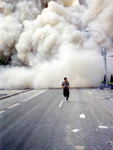What Students Should Know About 9/11 and the War on Terrorism
On Thursday, September 11, 2008, the Foreign Policy Research Institute will sponsor two webcasts on what students should know about 9/11. Schools may sign up to view either or both webcasts live online and participate in the question-and-answer periods. All questions not answered during the session will be answered by email shortly thereafter. The webcasts will feature speakers drawn from FPRI's Center on Terrorism, Counterterrorism, and Homeland Security.


